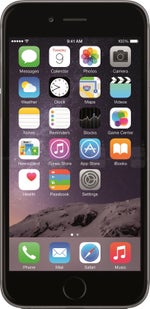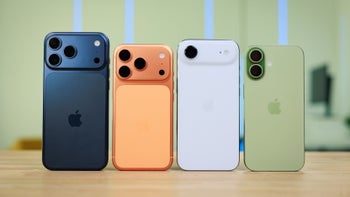Apple iPhone 6 vs Motorola Moto X 2014

Introduction
A couple weeks ago, we were treated to the unveiling of the latest Motorola flagship smartphone - the new Moto X. Well, the handset’s time in the spotlight was short lived because Apple’s latest smartphone, the iPhone 6, became available for purchase a short time later on. Arriving ahead of the upcoming holiday season, these two prized smartphones are no doubt going to be in heated contention against one another. Even now, as Motorola continues to fight with the heart of a champion, trying to do its darndest to one-up its rival, does the new Moto X have what it takes to disrupt the iPhone 6’s assault?
Design
Honestly, it’s really tough to say which phone has the more alluring design because they offer several unique qualities that make them so favorable. In particular, we absolutely adore the Moto X’s customizable design – one that Motorola established last year, and is something yet to be unmatched by its competitors. Thanks to the aid of its online portal, Moto Maker, buyers can select the colors of the handset’s casing, as well as its accents, to have a phone that’s uniquely different. And quite frankly folks, that’s one characteristic we love about the phone.
In contrast, though, the iPhone 6 exhibits a more premium design, as it features a unibody aluminum casing. Even though we’re only given three color options to choose from (space grey, silver, and gold), we can’t argue that these paints jobs help to complement the iPhone 6’s elegant and luxurious look. Due to its premium choice of materials, it also gives the phone a substantial feel in the hand. Well, the Moto X also feels quite sturdy as well – thanks in part to the aluminum frame that wraps along the side of the phone.
However, the iPhone 6 feels a little bit more comfortable in the hand. Not only is that aided by its rounded corners, but it’s able to best the Moto X in terms of its overall footprint. Essentially, it’s smaller and skinnier in frame, which allows us to better reach all corners of its display more comfortably. Despite that, the Moto X also feels good in the hand, especially if you happen to go with one of the leather finishes. Well, the material is better suited for giving us a firmer hold of the phone – whereas with the aluminum finish of the iPhone 6, it comes off a little slippery at times.
We can’t deny that these are two of the more attractively designed smartphones to have come out recently, but it’s a matter of personal preference in determining the superior design. If premium and compact are the qualities you look for, then stick with the iPhone 6. Go with the Moto X if you want a differently designed smartphone that you can create uniquely using different color and finish combinations.
Display
Lucky for these two, they manage to improve over their predecessors’ display resolutions. For the iPhone 6, it’s greeted to a 4.7-inch 750 x 1334 IPS LCD display, which by Apple’s definition, is a Retina Display due to its pixel density figure of 326 ppi. Meanwhile, the Moto X betters its predecessor by offering a 5.2-inch 1080 x 1920 AMOLED display, which one-ups the iPhone 6 with its higher pixel density count of 423 ppi. From a normal distance, however, it’s rather difficult to distinguish the difference in detail with the two of them, as they deliver pretty sharp results. Upon a closer inspection with our eyes, we can clearly make out the finer details with the Moto X’s display, though.
Don’t count out the iPhone 6’s Retina Display yet, just because it exhibits the characteristics of a high quality panel. In particular, it’s significantly brighter at 606 nits, versus the 385 nits tally of the Moto X. Not surprisingly, we see the results as we’re viewing the two displays outside with the sun directly shining at them – where the iPhone 6’s display remains visible, while the Moto X is nearly unviewable. In addition, the iPhone 6 is also better at reproducing colors realistically, which is an attribute that IPS LCD panels generally have. On the flip side, the Moto X favors over-saturated, vibrant but unrealistic representation.
Most people don’t mind the saturation, more so when the Moto X’s AMOLED panel has a vibrant glow in the dark that catches our attention. Again, taking that into consideration, the better display hinges at what you perceive to offer the more attractive elements.
Interface and Functionality
Android has this reputation for being a complex, features-rich platform that closely incorporates several of Google’s services. Well, there’s no denying the obvious there! From what we’ve seen, though, companies have customized the experience to their liking, which at times overcomplicates the experience. Rather than following the trend there, Motorola has simply favored to provide the Moto X with an intuitive stock Android 4.4.4 KitKat experience – one that’s surprisingly on the same plane as the iOS 8 in terms of simplicity.
That’s the beauty about the two platforms we’re comparing here, seeing that they provide us with enough enhancements to make the experience uncomplicated and intuitive. Looking at what Apple has done with iOS 8, they’ve kept true to the same approach of offering simplicity with its user interface. There are no app panels or endless menus to traverse through, in order to access a feature or something else. And that’s what’s so special about iOS 8, it doesn’t throw a million things at us.
Equally so, it’s the same with the Moto X’s Android experience. Unlike other customized Android experiences, the one here in the Moto X focuses its attention on a few, but handy ones that actually help to enhance our interaction with the phone. For example, Moto Display allows us to wave our hand over the display to quickly preview the time and any pertinent notifications. Additionally, Moto Voice gives us full control of the phone by just simply speaking the key phrase that we specifically have it set to activate on. Interestingly, Apple introduces a similar function with Siri in iOS 8, but unlike Motorola’s implementation, the iPhone 6 is required to be plug into a power source for an “always-on” reaction.
Diving deeper into what Apple has done with iOS 8, we’re especially pleased to find support for third-party keyboards – something that has been with Android since the early beginnings of the platform. Yeah, you can say it’s late, but we’re nonetheless pleased by its availability. One cool feature that we appreciate using with the iPhone 6 is its one-handed mode, where gently double tapping the home button shrinks whatever we’re doing to occupy the lower half of the screen – giving us better access to some things that otherwise require super stretching with our finger(s).
Processor and Memory
Using them independently, we can vouch that these high-end smartphones are capable of handling the toughest and most grueling processes we can dish at them. Basic processes, such as opening apps or just navigating across their homescreens, are all handled effortlessly with that fluid action we’d expect to have. Heck, even processor intensive tasks, like playing some of today’s 3D games, are handled well by them.
As we pay more attention at them simultaneously, we begin to notice that the iPhone 6 is slightly more responsive with heavy 3D gaming. On paper, its dual-core 1.4GHz Apple A8 64-bit chipset coupled with 1GB of RAM and a mighty PowerVR GX6650 GPU might not look as menacing as the Moto X’s quad-core 2.5GHz Qualcomm Snapdragon 801 SoC with its beefier sized 2GB of RAM and Adreno 330 GPU, but don’t let all of the numbers fool you. The iPhone 6 impressively shows us that it’s the stronger performer when it comes to serious gaming. Again, the Moto X is pretty darn good on its own, but we begin to realize it’s not in the same scope as the iPhone 6’s performance.
When it comes to storage options, the Moto X is available in only two capacities – 16GB and 32GB. Obviously, those are standard options for nearly every high-end device, but the iPhone 6 is available in 16GB, 64GB, and 128GB configurations. The beefier storage options are pretty attractive with the iPhone 6, especially when neither one has expandable memory to tap into.
Internet and Connectivity
For most consumers, they won’t care to know that the iPhone 6 offers support for more LTE networks than the Moto X. Regardless of that, neither one boasts a considerable advantage when it comes to the web browsing experience, since they have the same set of qualities that make the experience so enjoyable. From their sharp details, spacious sized displays, and fluid responses, there’s not one that’s dramatically better.
Being high-end caliber smartphones and all, they’re treated to the same set of connectivity features we’d expect from a contemporary device – these include aGPS with Glonass, Bluetooth 4.0 LE, dual-band 802.11 Wi-Fi, and NFC.
Camera
Last year’s Moto X didn’t quite enthrall us with its camera, more so when its results were rather underwhelming in tone versus the crop of competition it contended against during the time. Always a focal point for people, they’ve been treated to updated cameras that hope to be usable enough for a variety of shooting conditions.
Apple’s new toy is outfitted with an 8-megapixel camera, 1/3” sized sensor, f/2.2 aperture lens, 1.5µm pixels and a true tone dual-LED flash. Not one to be counted out, the Moto X comes at us with a 13-megapixel snapper, 1/3.06” Sony IMX135 sensor, f/2.2 aperture lens, 1.1µm pixels, and a dual-LED ring flash.
Similar to their hardware, their respective camera apps mirror one another. Specifically focused more on taking snapshots quickly, the two interfaces are light with manual controls and shooting modes. In fact, they both offer HDR and panoramic modes, but we really like how we can launch the camera app of the Moto X by merely flicking our wrist a couple of times with the phone in hand. Still, the iPhone 6 packs the speedier camera between them, since we’re able to snag a shot in under 2 seconds – and that’s with standard and HDR shots. In contrast, the Moto X takes roughly 3.8 seconds to capture a regular image, and an even longer 4.6 seconds for an HDR one. By no means is it slow, but the numbers show it’s not a lickity split as the iPhone 6.
Sampling its shots, we can’t complain a whole lot about their qualities with outdoor conditions – where there’s an abundance of lighting. They’re good, especially if we plan on using them for smaller 6” x 4” prints. Even though they excel the most in this particular condition, we notice that the iPhone 6 doing a better job with exposure, seeing that the Moto X favors a slightly more over-exposed composition – albeit, its HDR shots do a better job of offering a neutral exposure.
Where the iPhone 6 truly sets itself apart is its superior low lighting performance. Comparing the two, it’s instantly recognizable that the iPhone 6 snapshots are brighter and produce more details, while the Moto X samples are dark, which as a result, hides many of the details there in the shot. Indeed, its HDR mode helps to combat these issues, but it’s more prone to blurring. Luckily, the flashes of both phones cast a potent punch to light up the scenery, but the ring flash of the Moto X generally exhibits an over-saturated look – in comparison to the subtler, more natural look of the iPhone 6.
Likewise, video recording quality is pleasant with the two. Sure, there’s a details advantage with the Moto X’s 4K recording quality, but as we compare their 1080p samples, it’s actually the iPhone 6 delivering the goods to wow us. Some of its standout qualities include its slighter sharper visuals, smoother recording courtesy of its digital image stabilization feature, and adaptive continuous auto-focus. Additionally, we prefer the iPhone 6’s slow motion capture as well, since it’s capable of really slowing things down with its 240 FPS capture – whereas with the Moto X, it’s very light with its details.
Multimedia
Both phones serve their purpose when it comes to watching high-definition videos, but we kind of favor the experience with the Moto X just by a smidgen more. That’s because of its iridescent AMOLED panel, which radiates with juicy colors to keep our attention affixed onto it. Also, its slightly larger screen and front-firing speaker help to complement the overall experience.
We’re not necessarily in love with one music player over the other, seeing that the Google Play Music and iPod players feature very similar functions and layouts. Of course, the experience is strengthened if you happen to be a subscriber of their respective music services.
Carrying along single speakers for audio playback, they both sound pretty vibrant and full of substance – so we like the quality put out by the two. On paper, the Moto X’s rear firing speaker emits a stronger 75.4 dB of power, but the iPhone 6’s speaker is nearby at a respectable tally of 74.5 dB.
Call Quality

Moreover, voices are audible to comprehend over the speakerphone, as they produce distinctive voices that rarely require us to ask our callers to repeat themselves.
Battery

Diving in and comparing their results with our battery benchmark test, the Moto X is able to outlast the iPhone 6 by a slight margin. To be more exact, Motorola’s pride and joy cranks out a tally of 5 hours 45 minutes, which betters the iPhone 6’s mark of 5 hours 22 minutes. Honestly, these two aren’t particularly known for their longevity.
Conclusion
Apple doesn’t have to do a lot of fighting in the space, just because its iPhones continue to be at the top of the charts. Month after month, smartphone after smartphone, it simply has the rounded appeal and performance to be a choice winner amongst consumers. Considering all things, it makes plenty of sense why the iPhone 6 is already finding itself in a similar position of being king of the hill in the smartphone space. Heck, if we’re to objectively tally its performance in all key categories, there’s absolutely a lot more going for the iPhone 6.
Unlike its rival, Motorola is in an interesting predicament – one where they’re still trying to recapture the top spot in the leaderboards. We’ll be the first one to admit that the new Moto X is a solid offering, one that’s most notable for its customizable design and simple Android experience. Those two particular aspects are undeniably unique in the general smartphone space, and something that we continue to appreciate. However, for all work Motorola has done with its latest model, it still falls just a little short of the totality that comes along with the iPhone 6.
Its saving grace, however, is that it’s sporting the cheaper price - $99.99 on-contract for the base model, in comparison to the $200 on-contract cost for the iPhone 6. Naturally, if you’re tight with your budget, then the Moto X surely has plenty of value for you to like – not to mention, you’ll be saving some money in the process. However, if cost isn’t a factor to you, then we’d suggest picking up the iPhone 6. Well, that’s unless, of course, you prefer the cool and handy software features in tow with the Moto X.

Follow us on Google News






















Things that are NOT allowed:
To help keep our community safe and free from spam, we apply temporary limits to newly created accounts: